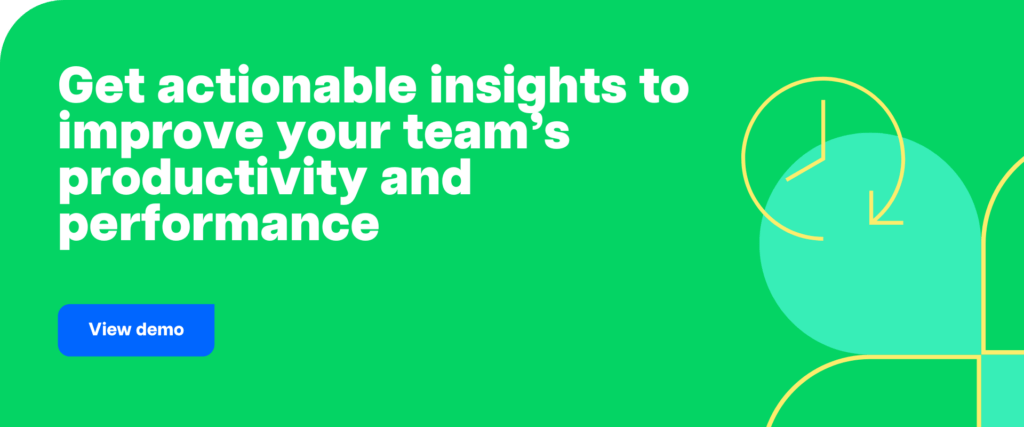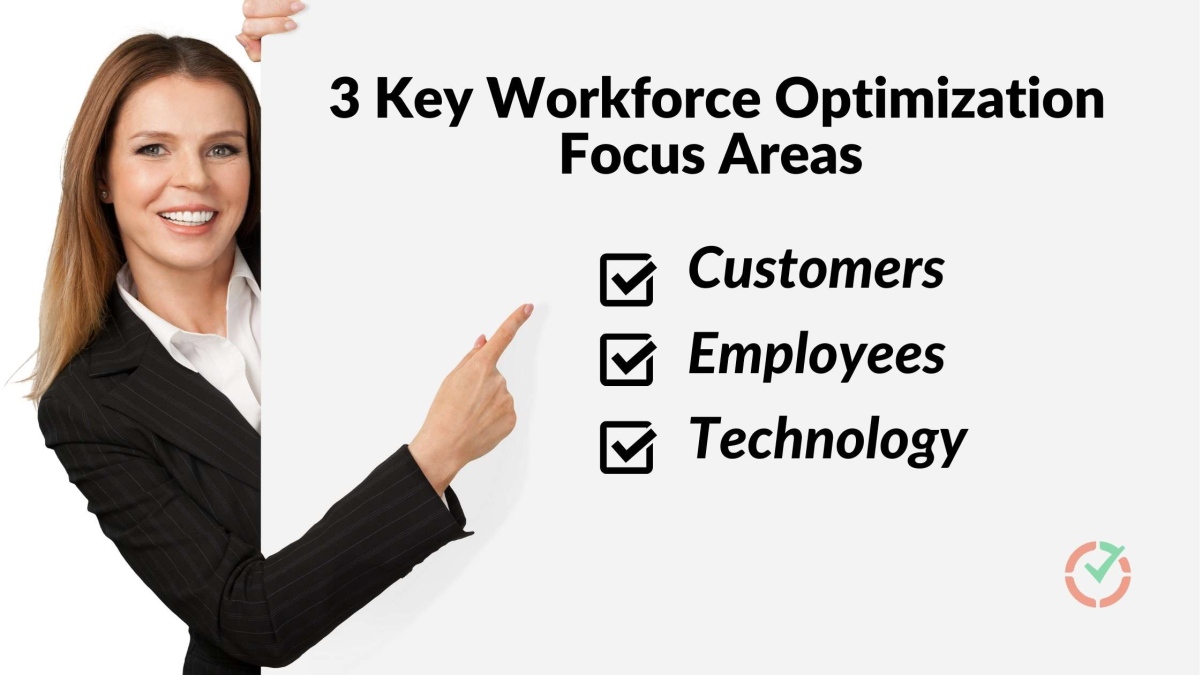Companies constantly have to find ways to streamline their business processes to keep up with changing market demands.
One way to do this is by implementing smart Workforce Optimization (WFO) strategies.
These strategies help improve employee efficiency by analyzing existing data for quality management and performance management. For a call center or contact center, this results in better customer service, satisfaction, and loyalty.
In this article, we’ll explore workforce optimization, the five essential components you need to look for in a WFO solution, and the three focus areas for successful WFO implementation.

Table of Contents
- What is workforce optimization?
- 5 essential components of workforce optimization
- 3 key workforce optimization focus areas
Let’s get started.
What is workforce optimization?
Workforce Optimization (WFO) is a blanket term for a set of strategies that help you improve employee productivity, efficiency, and performance through integrated software solutions.
It allows you to automate essential processes while emphasizing legal compliance and ensuring better decision-making.
WFO uses various customer and employee analytics to:
- Forecast demand and schedule staff.
- Match employee skills to the right job.
- Help you gain valuable insight into customer interaction analytics.
Simplifying these everyday processes can help save time and offer a deeper understanding of all aspects of your business.
Optimizing your workforce can lead to:
- Increased employee engagement and productivity.
- Reduced operational and labor costs.
- Increased brand visibility.
- Reduced compliance risks.
- Improved customer satisfaction and retention rates.
While WFO started in call and contact centers, companies soon realized these solutions could streamline operations and increase efficiency in almost any industry and department. Today, you’ll find workforce optimization strategies in industries like manufacturing, retail, and even financial services.
As WFO deals with the entire organization, you can use it to optimize different departments such as:
- HR (Human Resources).
- Accounting.
- Warehousing.
- Customer service.
- Back-office operations.
- Sales.
Simultaneously optimizing all these departments can lead to sustainable business growth.
Now, a workforce optimization suite typically includes:
- Quality monitoring.
- Performance management.
- eLearning tools.
- Speech analytics.
- Desktop analytics.
- Customer feedback.
- Call recording.
- Agent training.
- WFM tool.
Let’s explore each of these WFO components in more detail.
5 essential components of workforce optimization
While every business requires different capabilities to improve customer experience, call centers and contact centers have particular needs.
So, we’ll focus on the WFO suite components to optimize a call or contact center workforce.
Read more about the difference between call centers and contact centers here.
1. Quality management
Quality management software consists of many tools that allow your Quality Assurance (QA) team to monitor and review customer interactions.
A good quality management platform should support the following functionalities to catch errors in real-time and improve agent performance in the long run:
A) Screen and call recording
Recordings can help you assess the quality of your customer service and whether agents are following the correct procedures. You can also use past recordings for training purposes.
B) Easy-to-use interface
Ideally, it should be easy for the QA team to pick which agent they want to monitor, access their recordings, and leave reviews for later.
Similarly, agents should also be able to access their schedules, call recordings, and performance evaluations.
So, a simple yet dynamic interface can help QA evaluators, managers, and agents quickly pick up any inconsistencies in customer service and take corrective actions accordingly.
C) Customizable review forms
The QA evaluator uses review forms to measure how agents perform during customer interactions.
However, with increased training as well as changing tools and technologies, this score may change. So, you need customizable forms to include new metrics and changes in scores.
2. Workforce management
Wondering how workforce management (WFM) is different from workforce optimization (WFO)?
Let’s clear that up right away.
Workforce Management (WFM) is a set of tools and processes that helps with agent scheduling, forecasting demand, and overall planning.
On the flip side, workforce optimization (WFO) includes WFM along with other tools that help monitor and analyze employee performance through targeted analytics.
The goal of WFM is to provide a consistent service level during every customer interaction. And the following tools can help with that.
A) Forecasting tools
Forecasting looks at historical data to determine when customer demand will increase so you can adapt to the same.
In the long term, you can predict peak periods and provide adequate staffing levels.
B) Skills-based routing
Every agent and employee has unique skills and experiences. You can use your quality and performance management reports to ensure these skills are put to good use.
For example, let’s say you have an omnichannel contact center and an agent who’s experienced in social media messaging.
Assigning them to voice-based support can create friction and lead to employee dissatisfaction.
However, assigning them to your social media channels will help utilize their existing skills and improve your social media customer service.
C) Attendance tracking
A scheduling feature is only helpful if agents show up for their shifts. A real-time attendance tracking feature can hold them accountable for absences or late arrivals.
However, sometimes an agent simply can’t make it to a shift.
That’s why an attendance tracker with a user-friendly dashboard can help employees trade shifts while also keeping you in the loop.
3. Customer interaction analytics
Analytics help identify keywords from all customer interactions — voice and non-voice.
This AI-derived data allows you to see changing trends, gather invaluable customer insights, and act on them.
Some standard interaction analytics tools are:
A) Speech analytics
Here, the software picks up keywords from voice calls from both the agent and the customer. It analyzes speech patterns and emotional cues in real-time so agents can adapt accordingly.
B) Text analytics
Following the same concept as speech analytics, the software analyzes all non-voice conversations.
These could be interactions on live chatbots, SMS, social media apps, and email. That’s a lot of unstructured data spread across different channels.
Text analytics combines it all to create a cohesive view of each customer, providing valuable insight into their interactions with your company.
Doing this allows agents to identify issues and instantly change their customer service strategy.
C) Desktop analytics
Desktop analytics lets you correlate the context of the customer conversation, on voice calls or non-voice channels, with your agent’s desktop activity, i.e., what they’re doing.
This allows you to check whether agents appropriately utilize the available tools and provide the necessary customer support.
For instance, if the customer says they’re experiencing software malfunction, the agent should access the customer’s screen to figure out the actual problem. Similarly, you can check if the agent is utilizing your existing knowledge base to solve customer queries.
Desktop analytics can also help you decide which new technologies to invest in based on actual analytical data.
4. Performance management
Performance management allows you to communicate your company’s broader goals and monitor your employees’ progress on the same.
You can check your employees’ performance on specific KPIs (Key Performance Indicators) through a QA scorecard or a dashboard.
A good performance management system should feature:
A) Automated data collection
Business Process Automation (BPA) allows you to standardize time-consuming tasks like data collection. These automated processes also help reduce human error and save costs.
Additionally, the software lets you immediately review and analyze the data, giving you and your agent opportunities for real-time coaching.
One such productivity management tool is Time Doctor — trusted by many small as well as large businesses. Time Doctor helps you create automated timesheets, giving you insights into employee performance and how to improve it.
You can read more about Time Doctor’s features here.
B) Seamless integrations
To have a complete picture of your operations, you’ll need to integrate various software systems. It can include everything from a CRM (Customer Relationship Management) tool to employee attendance systems.
Your chosen workforce optimization software solution should allow you to integrate these third-party applications seamlessly for increased data flow and visibility.
C) Coaching software
Monitoring your employees’ performance can help you understand which KPI they’re struggling with and provide targeted coaching.
Coaching can be in the form of one-on-one training sessions or through training software.
5. Gamification
Most companies use gamification elements to increase customer engagement, such as awarding loyalty points with each purchase.
For workforce optimization, you can use these elements to reduce call center stress, increase agent productivity, and foster a positive work environment.
A few ways to do this include:
A) Challenges
You can create challenges where the agent with the best metrics, e.g., the lowest call handle time, wins a reward.
You can also turn them into team challenges to encourage employee bonding.
B) Badges
Once an agent wins a challenge, you can also give them a badge, ribbon, or medal.
It acts as a physical representation of their hard work and the company’s recognition of it.
C) Points and rewards
Going with the customer angle, you can award employees points when they meet their targets early or complete specific tasks. They can collect these points and exchange them for rewards, such as paid time off.
All of these components can help improve your employee’s productivity and lead to better customer service.
But to get the most out of your software suite, you need to know the core WFO focus areas and how they all interact with each other.
3 key workforce optimization focus areas
Effectively implementing a workforce optimization solution requires you to invest in three key areas:
- Customers.
- Employees.
- Technology.

Let’s explore what that means and how to go about it.
1. Adopt a customer-centric approach
For a call center or contact center, the main aim of workforce optimization is to improve customer service. That’s why you need to consider the customer’s view.
For example, you can analyze your recordings to see what are the common complaints.
Similarly, you can look at automated reports to see where communication frequently breaks down and bridge those gaps.
If you need actionable insight into your customers, you can ask them to fill out a survey about their experience with your company and customer service. Analyzing your customer experience feedback also helps you take an objective look into your operations and make the necessary changes.
For example, let’s say your customers specify they receive inconsistent service. You can use that to train your employees and emphasize consistency across the board.
In the end, you would have prioritized your customer’s happiness, provided growth opportunities for your employees, all while implementing an intelligent business strategy.
2. Invest in your employees
Employees are your most valuable business asset.
If they aren’t satisfied with the work or with your company, their engagement levels will drop and, with it, their productivity.
According to a Gallup study, only 20% of employees are actively engaged in their work.
You can change this by investing in your employees — recognizing their accomplishments, setting clear goals, and defining their career path from the get-go.
Another way to improve employee engagement and loyalty is by helping them maintain a healthy work-life balance. You can ensure this by:
- Offering flexible and remote work opportunities.
- Encouraging employees to take regular breaks to avoid working long hours.
- Increasing support for working parents.
- Incorporating wellness programs.
- Focusing on productivity rather than long hours.
When employees feel valued at work, they feel more engaged and loyal to their workplace. As a result, they feel motivated to give their best and help the company grow even faster.
This focus on employee engagement is one of the reasons why the industry is moving away from the term Workforce Optimization (WFO) to Workforce Engagement Management (WEM).
3. Give employees the tools they need
Even the most engaged employees can’t give their best if there are constant roadblocks while operating the systems.
Investing in new technologies doesn’t just improve employee performance and workflows but also helps with customer service.
For instance, most customers today expect quick responses to their concerns or queries. If you can’t provide that, they might leave you for your competitor who can.
So, you may decide to add a chatbot to your site for 24/7 service. This will reduce customer wait times and help your contact center agents focus on more complex issues. You can further increase operational efficiency by automating routine tasks like data entry.
Using the contact center example, you can record the entire customer journey using automation in a CRM system.
As a result, your agents will have all the customer’s information at their fingertips, allowing them to provide fast and personalized customer service. It can also increase customer satisfaction as they don’t have to repeat details at every step.
However, not everyone is comfortable with new technology.
That’s why, when you introduce new tools or update existing ones, ensure you provide employee training sessions. These sessions will familiarize your employees with the software and give them ongoing learning opportunities.
Wrapping up
Workforce optimization can help your business reach new heights while reducing operational costs. It allows you to take decisive action based on existing data and analytics.
An effective workforce optimization software also helps streamline business processes and workflows. This can lead to increased employee efficiency, engagement, and productivity.
In turn, these changes improve customer satisfaction and aid customer retention, allowing you to create a business that’s equally focused on employees and customers.

Andy is a technology & marketing leader who has delivered award-winning and world-first experiences.


